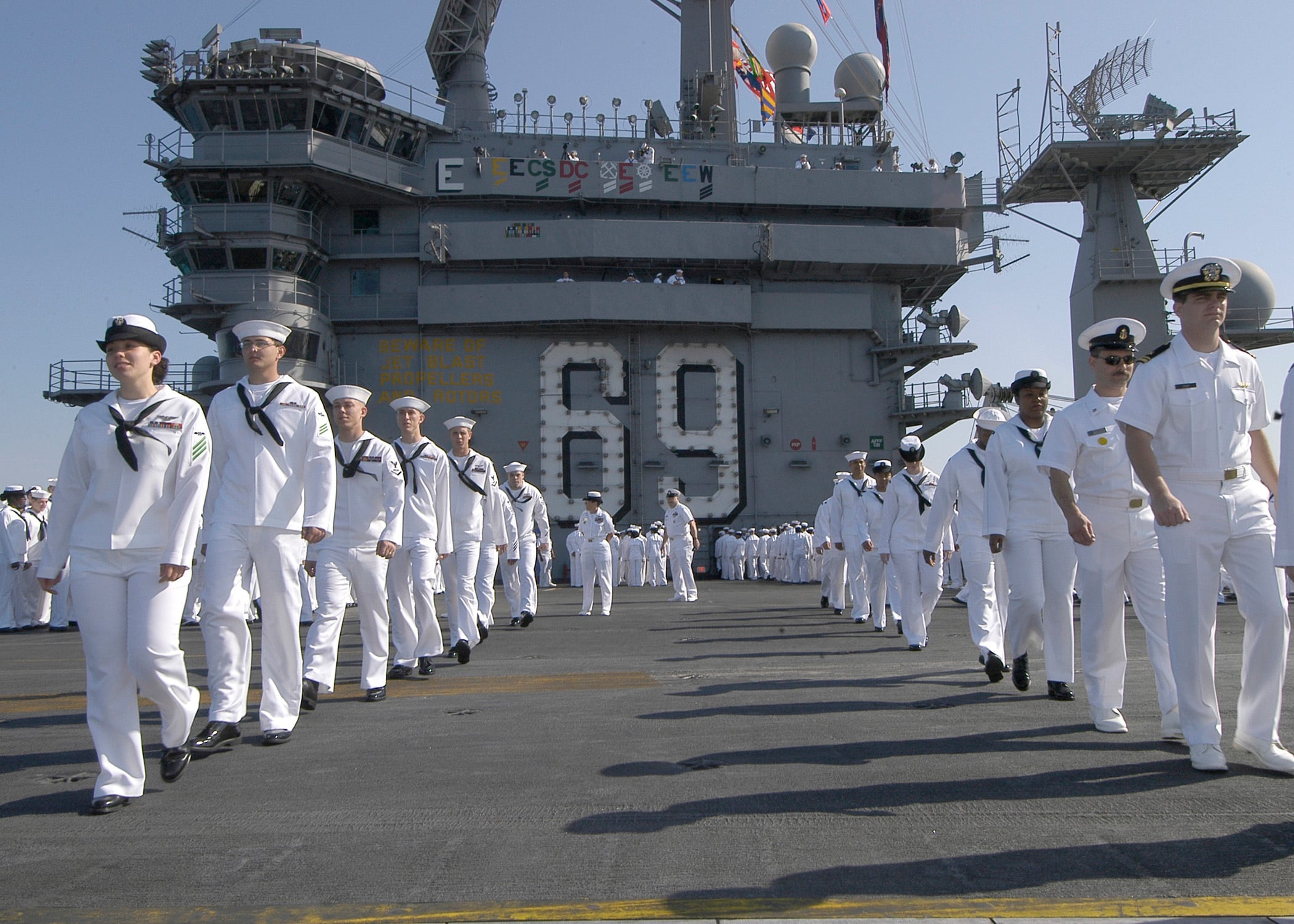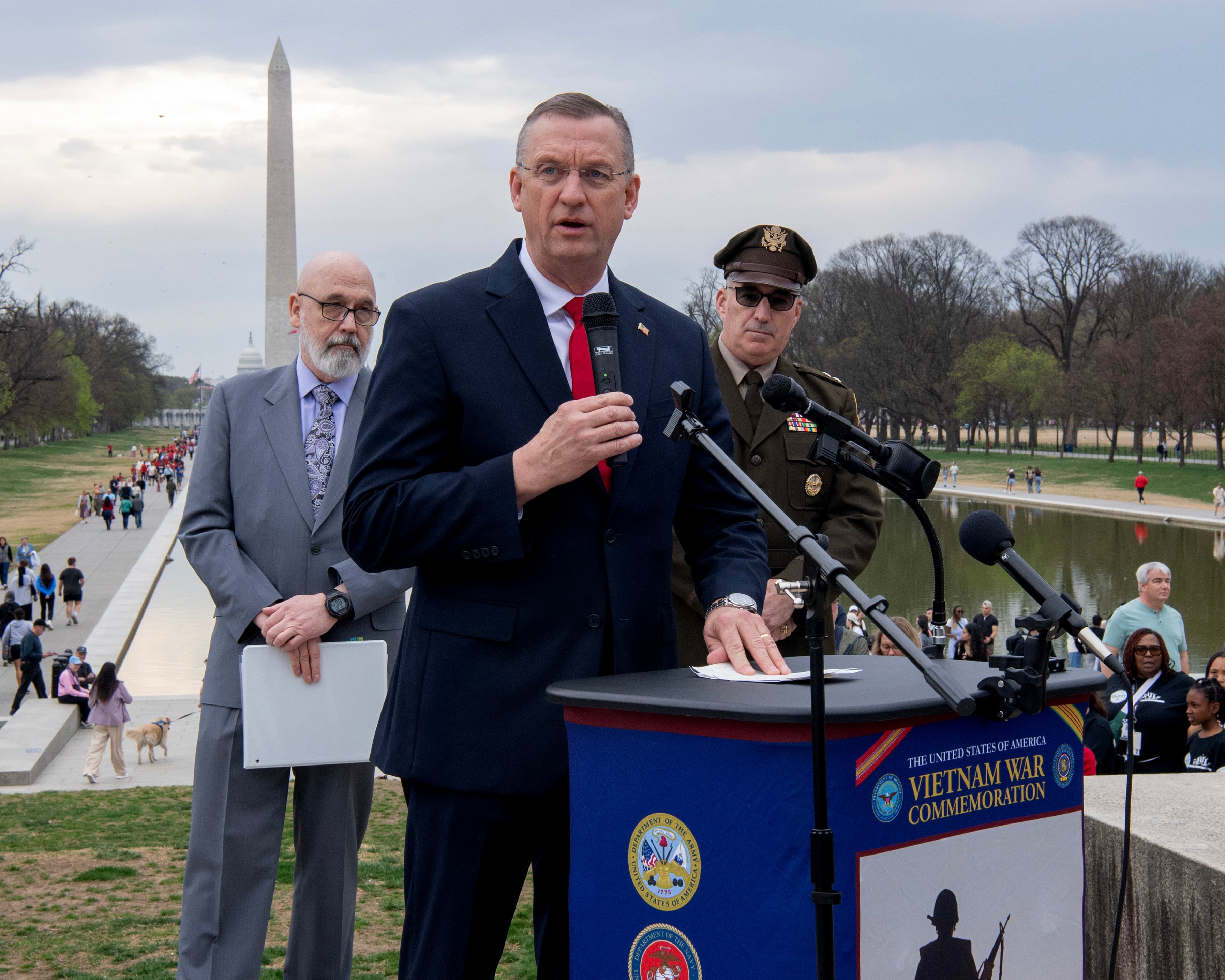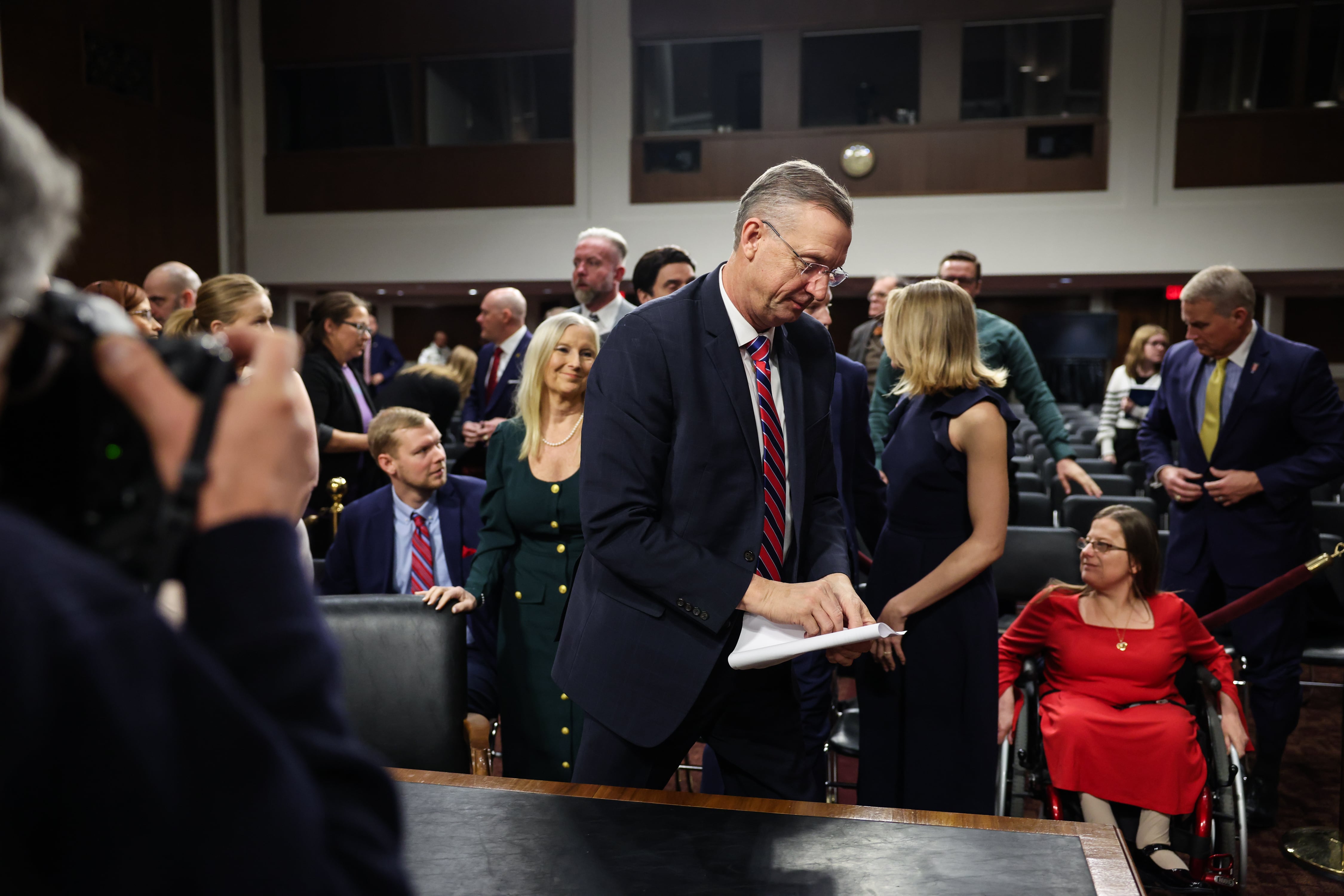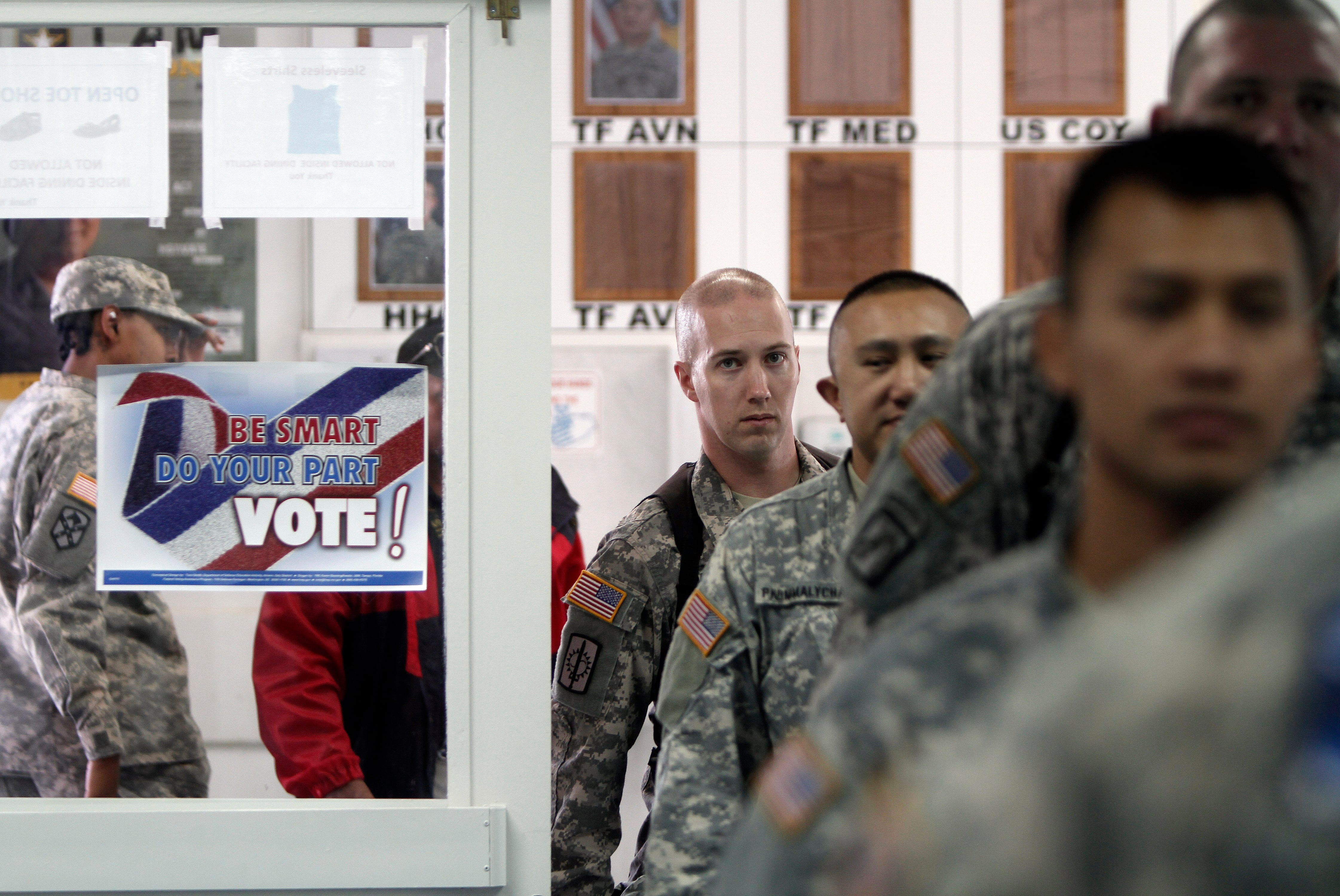After months at the forefront of the conflict against Iran-backed Houthi rebels in the Middle East, the aircraft carrier Dwight D. Eisenhower concluded 275 days at sea and returned to Naval Station Norfolk, Virginia, in July.
The Eisenhower entered the U.S. 5th Fleet area of operations in November, just weeks after the start of the Israel-Hamas War. The ship’s arrival in the region marked the first time a carrier operated in those Middle Eastern waters since the end of the Afghanistan war in 2021.
While there, the strike group shot down a barrage of Iran-backed Houthi drones and missiles on a regular basis – earning the crew the Combat Action Ribbon for their actions. The carrier’s air wing also led the first strikes against Houthi facilities in Yemen in January, and employed several weapons in combat for the first time.
Capt. Chris “Chowdah” Hill, the Ike’s commanding officer, spoke to Navy Times this month aboard the Eisenhower about how the crew navigated the conflict in the Red Sea, led the international effort Operation Prosperity Guardian to safeguard civilian merchant vessels in the region and how leadership worked to maintain morale among the crew through multiple deployment extensions.
This interview was edited for length and clarity.
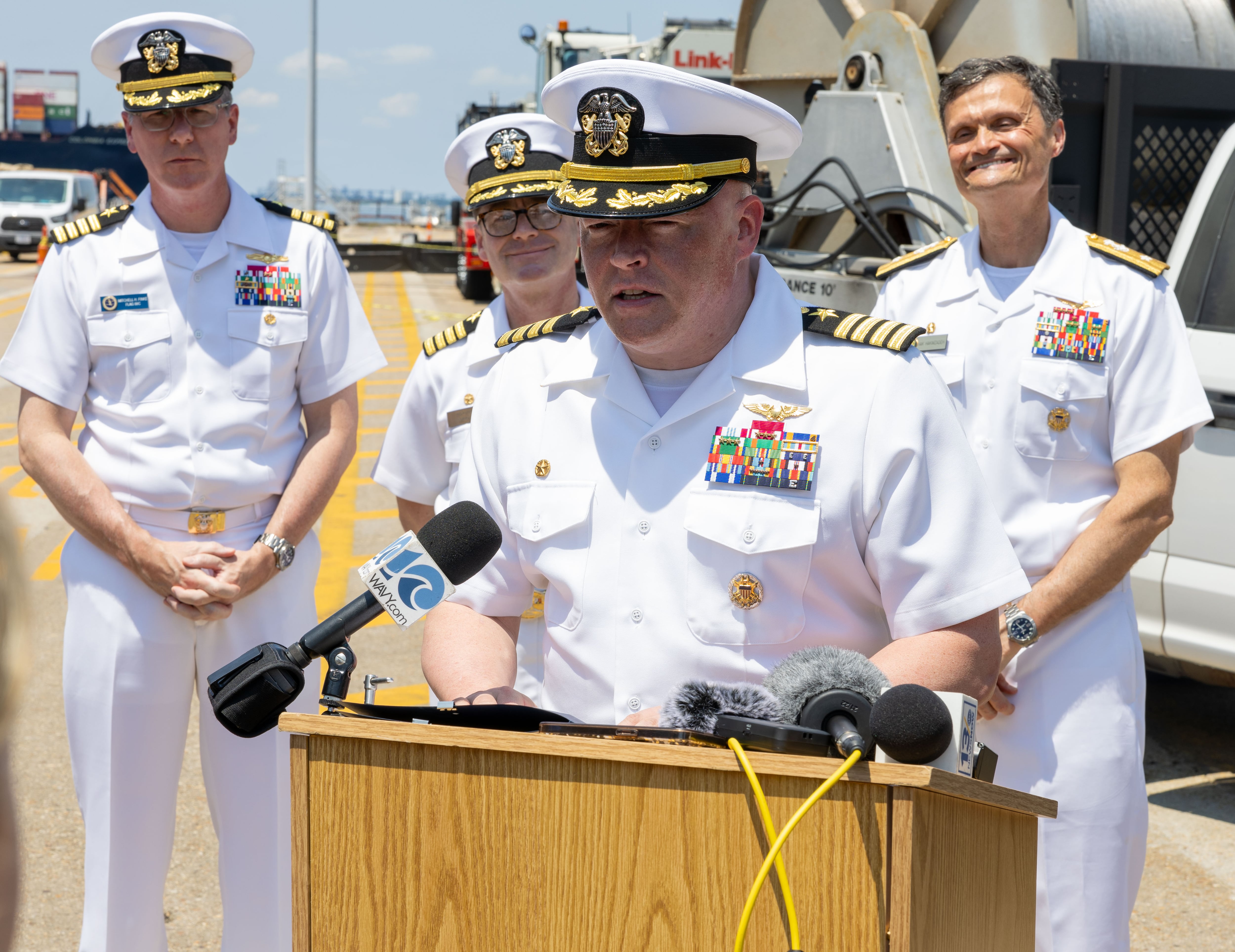
Navy Times: This was an historic deployment on so many fronts, and Navy leaders have described the conflict in the Red Sea as the Navy’s most kinetic conflict since World War II. So to start off, I wanted to get your perspective on what were some of the key takeaways and memorable moments for you from this deployment?
Chris Hill: I could talk about this all day. So I would characterize it overall as the most complex naval engagement for the U.S. Navy since World War II. And I’m looking back to Korea, Vietnam, Persian Gulf, Gulf War II, all that stuff – just a very busy situation in the Red Sea involving multi-domain threats on the surface, in the air, and new kinds of systems, like some of the new drones and some of the anti-ship ballistic missiles, which had never been fired in combat until this moment, and the first time they’ve been shot down, which we did.
So that was unprecedented, in that sense. We’ve overused that word on our end, but it was truly unprecedented. The admiral and I and other warfare commanders, with our combined experience, anywhere from 25 to 35 years in the Navy, we hadn’t seen anything like this, right? So the big question is, were we prepared? So that’s a question that we have to look at throughout.
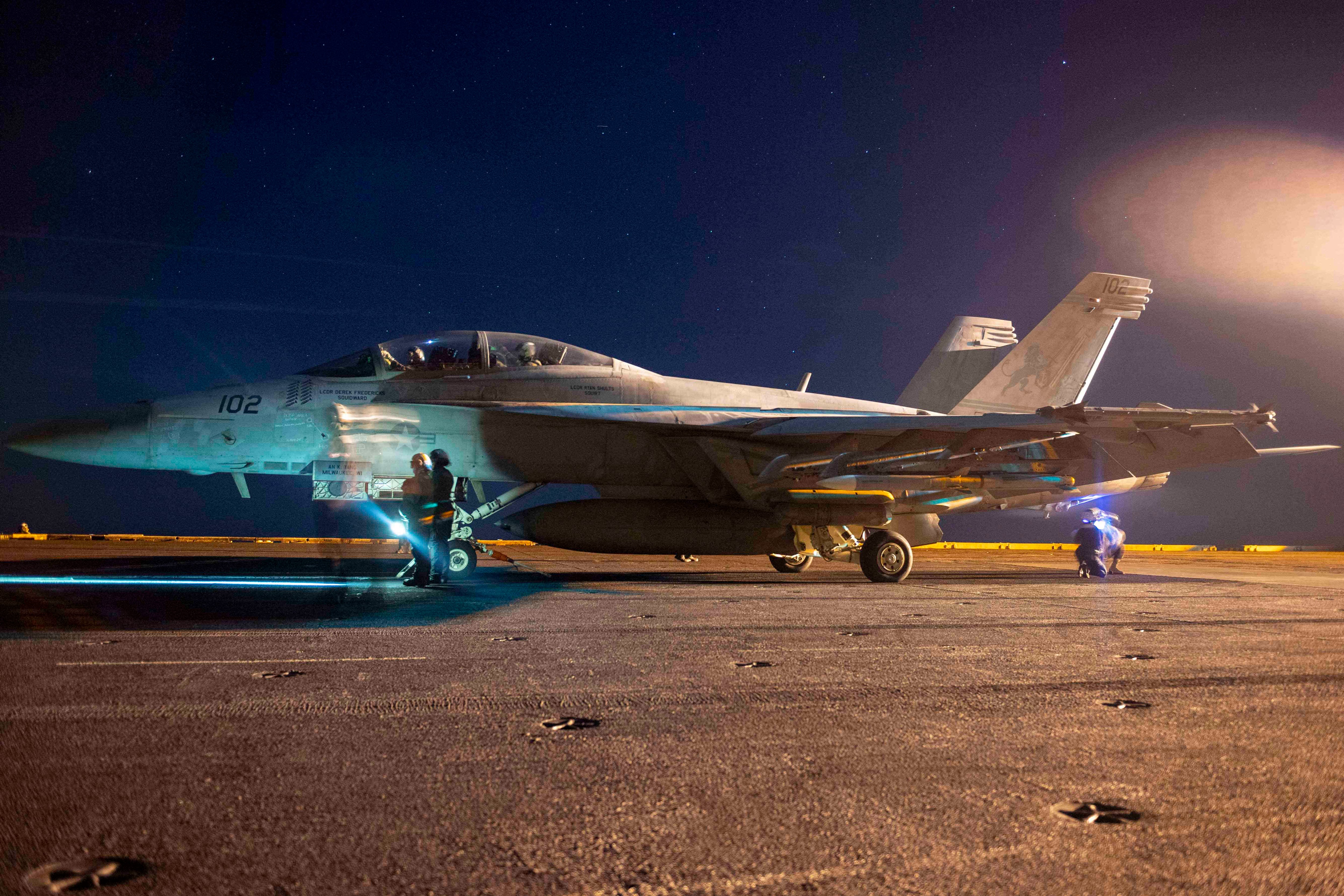
But going back, for this ship, the USS Dwight D. Eisenhower, it’s an older ship, going on 47 years, still fully capable. The ship did two back-to-back deployments during COVID in 2020 and 2021. A lot of sailors didn’t get to see the world, which is quintessential Navy – go visit port calls and interact with local populations. And that has a strategic impact of some sort as well.
So leading up to deployment, we are expecting to do something more akin to what we did in the 80s and 90s – some NATO engagements, lots of port calls, mainly focused in the Med. It was very exciting for sailors. We talked about it all the time. I made a lot of promises, and it all went out the window on Oct. 7. So Oct. 7 occurs, Hamas invades Israel, and we’re deploying on our normal schedule a week later on Oct. 14.
We didn’t really have a specific mission yet, because the situation was still developing, but we were given orders to…meet up with the Gerald R. Ford in the Eastern Med, which we did. While we’re en route, the USS Carney was ahead of us by about a month I think, maybe a little bit more, but they were already in the Red Sea and they happened to be in a position where they intercepted dozens of missiles and drones early on.
So that was kind of a foreshadow of what we would expect when we got there. And so we ended up going to the Red Sea, but we were just transiting through initially. Ultimately ended up in the Persian Gulf or the Arabian Gulf to counter Iran. And then we weren’t there too long before we were directed back into the Red Sea because of the situation there where the Houthis were essentially targeting merchant vessels, making an attempt to shut down the Strait of Bab el-Mandeb. So on Dec. 31, we went back into the Red Sea. We remained there for about six-and-a-half months and were engaged very frequently, both defending other ships, defending ourselves, and also bringing the fight to the enemy quite regularly.
NT: Tell me a little bit about Operation Prosperity Guardian. What was the Eisenhower’s involvement with that like? How did that effort form, and what kind of support did the Eisenhower and its strike group provide?
Hill: We were the main element of Operation Prosperity Guardian, which was designed to defend merchant vessels and that involved providing escorts and just defending ships whenever we could. Doing a wholesale escort mission in an area that is that congested is really hard for a single strike group. Having said that, we were regularly saving a lot of lives. And that was the implied mission, it wasn’t the stated mission. Stated mission was to degrade Houthi capability and also provide protection. So we did both of those simultaneously while we were out there.
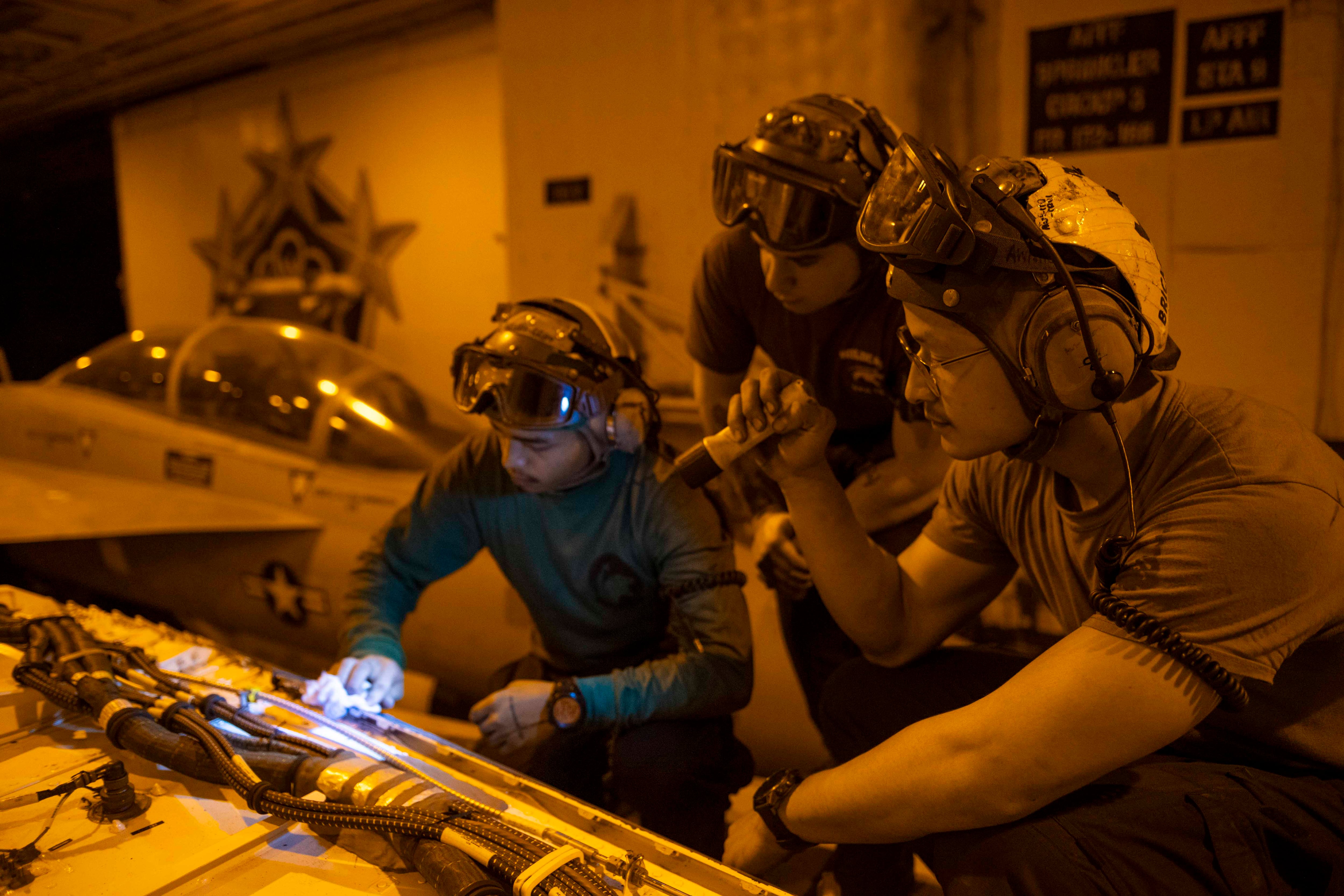
NT: The last time I was on this carrier was before getting underway during Large Scale Exercise. At the time, there was a lot of talk about being in the 6th Fleet, but always being prepared for things to change. And you mentioned in your first response a little bit about how things changed after Oct. 7. Can you share what that was like, realizing that the carrier might head into the Middle East for the first time since 2021?
Hill: When we’re doing our our work ups, it ends in a capstone event called Composite Unit Training Exercise, or COMPTUEX, about five to six weeks long involving the entire strike group consisting of four destroyers, a cruiser, the aircraft carrier, the embarked air wing and staffs, anywhere between six and 7,000 people overall involved.
We prepare for a range of threats, some of the most high end threats, to some of the threats that are currently in existence that we have dealt with over the past 10 to 20 years. So you create a range of a threat so you could be deployed to any theater – 7th Fleet in the Western Pacific, or in the Middle East. I think we got sufficient training in that process, because there was a lot of variety. We were evaluated. We did well, but you never know what to expect, right? In every single conflict I’ve been involved in, there was always a learning experience that had to happen. After day one, you start to look at, okay, what does the enemy have, and how are we going to counter it? We’re professionals. We sit down, we plan these things out. And if the plan doesn’t work, we debrief and we immediately change it, right? We have kind of this rapid learning process.
We also had organizations back home, technical organizations, part of the Navy, that could say, “Hey, you need to use this tactic or this technique or this procedure, and it will help.” So you have tremendous support stateside to feed us information. So learning was constantly happening, and it was very effective. So I can’t really say that we were surprised by anything. It’s the expectation in our culture that you will see things that you didn’t expect, and then you do something about it.
NT: You mentioned that the leadership of this strike group has 25 to 35 years experience, and yet you’d never seen anything like this kind of conflict. What was that learning curve like, and how did you adapt as the deployment went on to some of these threats?
Hill: We had all been involved in other combat operations, right? For me, for example, flying the E-2 Hawkeye, I was used to doing command and control – both in training, in combat – of running the air battle, right? So that was kind of intuitive for all of us. So in that sense, there was no, no surprise, right? It was easily adaptable for us. One of the things we had to look at, though, was how is this going to impact the crew, being in this environment? So a lot of questions came our way. How is the crew doing? What are you doing for the crew? And it became an item that we talked about with media locally.
I would say things like, “Hey, the crew is doing great.” And occasionally I’d have a sailor that would come up to me say, “Sir, I don’t agree with you. I’m not doing great.” That’s partly because we’ve all been on short and long deployments. Even if you’re not doing combat, being at sea in an austere environment like the Red Sea, where it’s hot, the water’s hot, so the engines aren’t as efficient. It impacts your quality of life. And this is a known thing by sailors going back centuries. It is a tough life by itself.
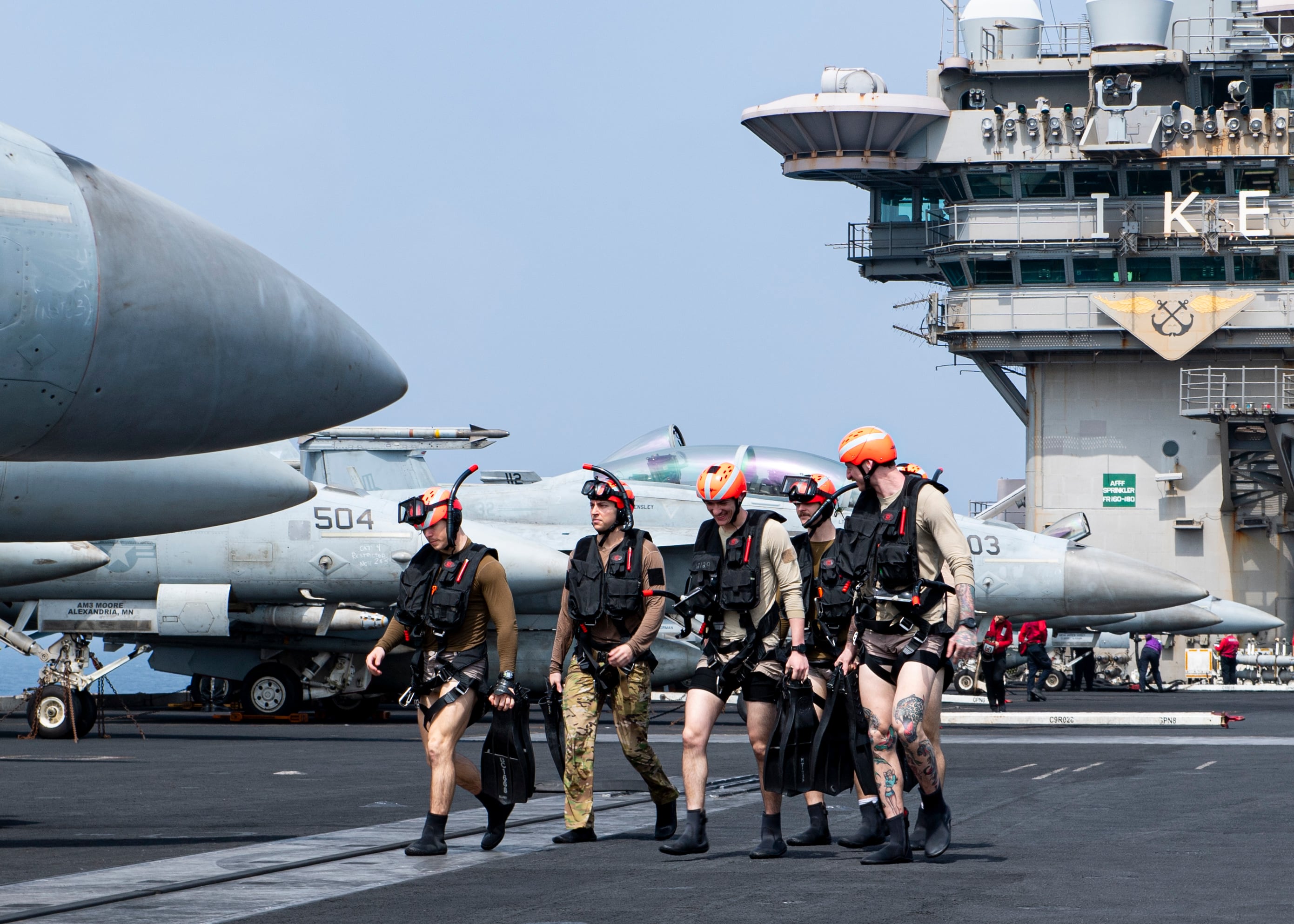
Now you add the complexity of warfare, I would say the warfare element was inspiring to many. And I talked about that – we felt like we had mission and purpose. We were actually doing something to make a difference in the world. We were affecting the enemy. We were showing American resolve by being there, right?
You know, I would say to sailors, “What if America said, ‘You know, we don’t care. We’re not going to show up.’” That’s not what we do with the United States Navy – we care about freedom and navigation as part of our core mission going back to 1775, right? So, a lot of discussion about that throughout the ship to remind the sailors that they were really contributing to something significant, and also mentioned the fact that, “Hey, what is going on is unprecedented for the U.S. Navy at least in modern history going back 70 years.” That was what contributed to morale in the positive. It might have been the one thing that sustained us through an extended deployment in the aggregate.
So we’re looking at all these things as we’re evaluating how we did, what we could have done better – there’s always room for improvement on any deployment. But that was a big takeaway: the mission and purpose matters. And how do you measure it? How do you measure morale? I joked back in the day that I can measure morale by counting smiles.
But it’s really hard to quantify. You can get it through feedback from sailors, so you have to now elicit feedback. I would bring sailors in this very room right here, 10 to 15 sailors a couple times a week. Through over the past almost year-and-a-half now, I have seen more than 2,700 sailors come through this room. We talked about morale, how the morale was, what we could do better – listening to sailors try to get that feedback. And then explaining my philosophy, and I had expectations for them. They were required to love and value each other. And I realize sometimes, if everybody’s your brother and sister, that doesn’t mean you actually get along with them every time. But the expectation is they are your brother and sister, so you still love and value them, right? And at the end of the day, if someone’s going after them or they’re getting attacked, you’re going to jump in front of that system. That’s the kind of environment we wanted to create – that’s sort of like the warrior mindset or warrior ethos.
NT: Speaking of morale, I understand that the ship had Wi-Fi during this deployment and I wanted to ask how that contributed to morale and also combatting disinformation.
Hill: Wi-Fi is a game changer here, right? And I realize that there are operational security concerns, there’s times when you have to turn it off. It could expose you to hacking and all these other things that we worry about, and we have plans in place to mitigate that stuff. But as a human person, when you’re having a tough day, who do you call? Right? Do you call mom and dad? Do you call your spouse? Everybody has their call person.
Sometimes the connectivity doesn’t work. We had some connectivity issues with Wi-Fi. When you have 5,000 people trying to get on a system with only a handful of satellites to connect to, it was a challenge, but I’d like to see the Navy continue this process in a very careful, measured way to provide those resources to sailors so you can allow them to connect to their external support networks. That might be the thing that gets them through a tough day. We all have tough days. This is normal human behavior, right? What is the thing that can get them through? If Wi-Fi is a conduit for that, then let’s invest in this, right? The technology exists now. It’s less expensive than it was, say, 10 years ago. Let’s take advantage of it.
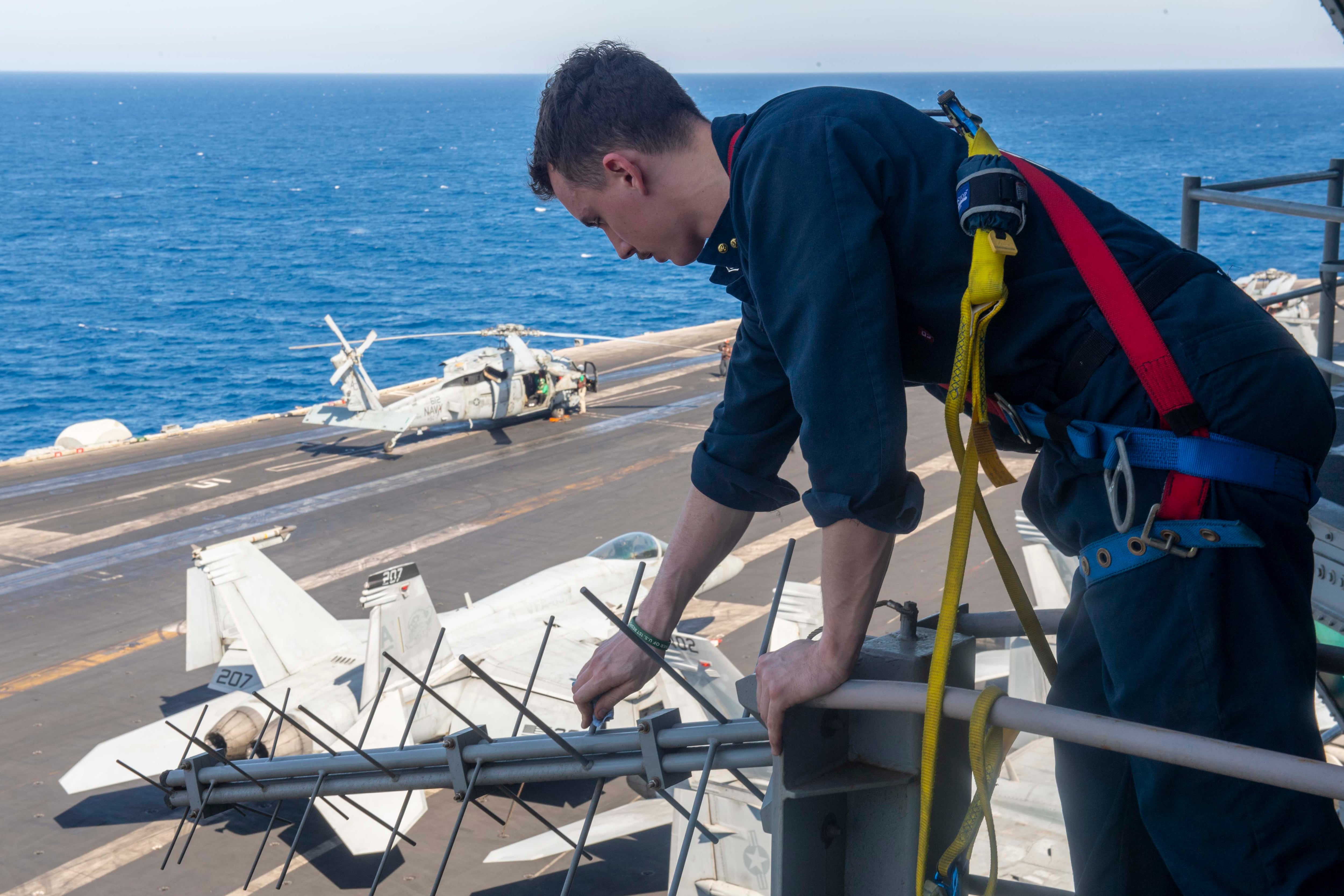
Also, the Wi-Fi opened up an opportunity to get into a little bit of more social media, right? So I was never a social media guy. I was always wary of it. I’m not the kind of person that likes to show pictures of myself, and very reserved in that sense. But I decided to take a risk, working with my public affairs officer, I said, “Why don’t we use one of the social media sites, and I’ll actually talk about my leadership philosophy or something like that.” But it actually took off in a weird way. Parents got involved because they’re worried about their sailors, right? Just like my mom was. And so I would get hundreds and hundreds of requests to see pictures of their sailors, and I couldn’t keep up with it. I didn’t have enough time in the day for something like that. But every day, I would try to bring up one sailor and show them off to the world, and just show the world that these are normal, ordinary young folks doing extraordinary things, and some people found some beauty in that, and so we just kept it going, right? Also, I gave them a cookie.
22-yr old cryptologic technician technical from Euless, TX was requested to the bridge by her uncle. She works in intelligence and anti-ship missile defense (how crazy is that?!). How did she survive 9 months of deployment?
— Chowdah Hill (@ChowdahHill) August 25, 2024
Gym and jujitsu! Her advice to others: “Find peace in… pic.twitter.com/bMkWzIYdwW
I’m not trying to recruit for the U.S. Navy by any means, but maybe I’m recruiting the parents so that they can convince their children that it’s an environment where it could be enriching and could change their lives. Which I do get to see all the time as a leader of a ship, right? We as leaders, we see this, and this is what kind of motivates us to continue on, like a school teacher. Seeing a student start, mature, and get better in class – it’s motivating for a school teacher.
Someone had said in the media that this social media was sort of an information warfare campaign of some sort. It was not intended to be that way. If it just so happened that the enemy claimed they sunk the ship – which they made several claims, but they didn’t touch us – I could show a picture of the flight deck and show life as normal. I could show we’re baking cookies. Capt. Demo, our facility dog, is walking around the ship just like a normal day, which was all true, right? So if you want to call that information warfare, have at it.
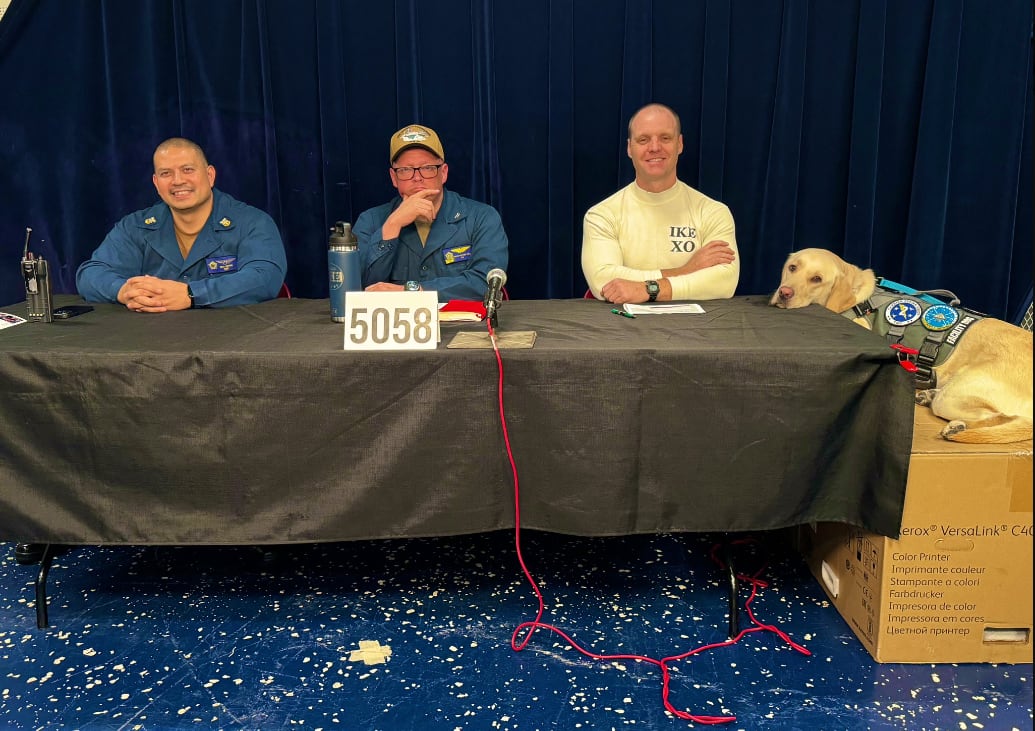
NT: I know the carrier air wing was incredibly active during this deployment, and led the first strikes against Houthi facilities in Yemen. And then they also fired off several weapons in combat for the first time. So what was the decision-making process like between you and the CAW, and what was it like to employ these weapons and conduct these strikes?
Hill: In terms of striking, it’s an interesting process, and you have to bring in our intelligence specialists and their leadership that actually tries to find the targets, and then you have to vet it. And that vetting process, depending on what theater you’re in or the intensity of the war, typically goes up a chain of command off ship. And they could say, “Yes, we approve that target,” and then we will do the weaponeering. So we have people that are experts on that, and that’s usually coming from the air wing. So they’re saying, “Okay, for this target, we need this type of weapon, missile or bomb.” You want to minimize collateral damage. You don’t want to escalate the problem, right?
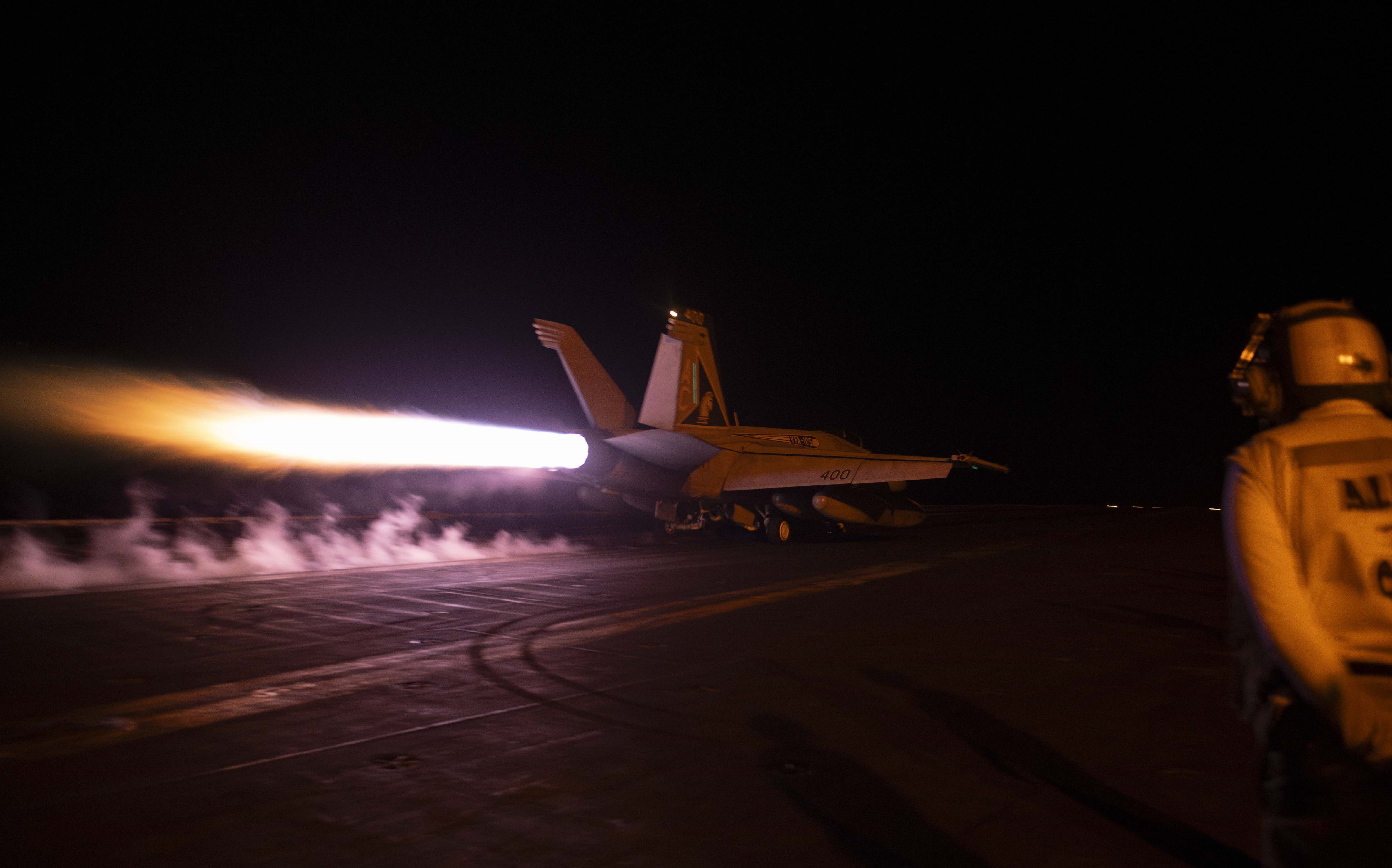
We’re very, very careful about that. This isn’t World War II, right? And plus, we don’t want to expend and waste things that are not going to strike. Our weapons are extremely precise, and we want it to stay that way, right? Only target the stuff that needs to be targeted. And then, when that decision is made on the type of weapon, then they come to me, because I’m the holder of the weapons and I have two giant weapons magazines. The ability to fight a war long term – I can’t give you the amount of months, because it depends on the intensity of a given day – but I could have gone on indefinitely, probably a minimum of 10 more months, given the equipment I had. Maybe there would be an occasional reload of this or that, or the other type of missile, bomb. But extraordinary capability within an aircraft carrier with its embarked air wing to fight a battle.
All of our weapons have evolved over time. This was the first time we’ve seen ballistic missiles shot in combat. First time they’ve been shot down by our ships. So that’s different. We knew drones were coming. We’ve been talking about this for decades, and now we saw them. So we had some foreshadowing with the Carney, and so nothing was a shock to us, right? It was more, “Hey, this is interesting. Let’s do what we do and figure out a way to stop it.” And we were doing that regularly.
NT: What were some of the biggest challenges you faced during this deployment?
Hill: One of the things that I was challenged with was making sure people were getting the right amount of sleep so that they could perform well, that they had good reaction times. Mood matters to me, how you interact with other sailors, and a lot of that can get ruined if you’re not sleeping. And I would say, I don’t think the Navy historically has done a great job on sleep hygiene, but we’re getting better. So a lot of leaders are talking about it. We understand the value of sleep. So when you’re in actual combat, it’s quite frequent that you have to launch alert aircraft to go after a target or something, which we did many times, that might not fall into the window of our normal flight ops. So we’ll have a normal battle rhythm, anywhere between 10 to 14 hours per day, flying aircraft throughout the entire day. It’s cyclical, right?
But what about when we’re not there? If it’s a single carrier, we have to provide alerts at night, sometimes in the very early morning. The air wing as well, we had to make sure we very carefully monitor when people were actually sleeping and that that sleep occurred at a normal time. You can’t just say, “You can now do your eight hours of sleep right now.” You have to time it so that’s the time when they normally sleep. So creating the sleep battle rhythm that’s circadian friendly, that allows people to be alert and respond to any threat. So we did a little bit of adjustment on that, because we didn’t expect to do as many alert launches, and we did a lot.
NT: I know one thing the commanding officer of the Carney said after returning from deployment was that there were a lot of quick decisions that had to be made navigating this conflict in the Red Sea and the Middle East. Can you speak a little about that, and what that was like for the Eisenhower?
Hill: I would say the quick decisions were largely with the destroyers. Ballistic missiles were not a concern for me, because I had them as protection, right? But the response time is just seconds. They have to identify and make a decision quick. But we train our operators to make the decision without asking permission from the captain of the ship, who might be sleeping at that very moment or doing something else. Or he’s got a radio on him, and for whatever reason, it’s not working. It’s garbled. So our tactical action officers, the people that work in our combat cells on every ship, are trained to respond very quickly. Also our systems help you in that matter. Like these are pretty advanced algorithms of these systems. They can help you identify a threat, provide you with recommendations. So that makes the process easier, right? So very impressed with both the equipment we had, the missiles we had, and how the sailors performed. It was like a perfect nexus of all three.
NT: There were multiple extensions during this deployment. You guys were gone for a long period of time, and now there’s two carriers in the Middle East. In terms of pacing, how long do you think carriers can be engaged in this kind of conflict?
Hill: If you look at it isolated, we are capable of being engaged forever. Any ship is capable of going for years on end without returning home. We have that capability. We just don’t exercise it because it’s an all-volunteer force. We want to get people home, cycle other people in. Some need the experience in that environment, but that’s looking at things isolated. We also have other parts of the world where we want to be, so we have to carefully apportion where our carrier strike groups are, and manage that appropriately. So that’s stuff that we think about and talk about all the time on our end.
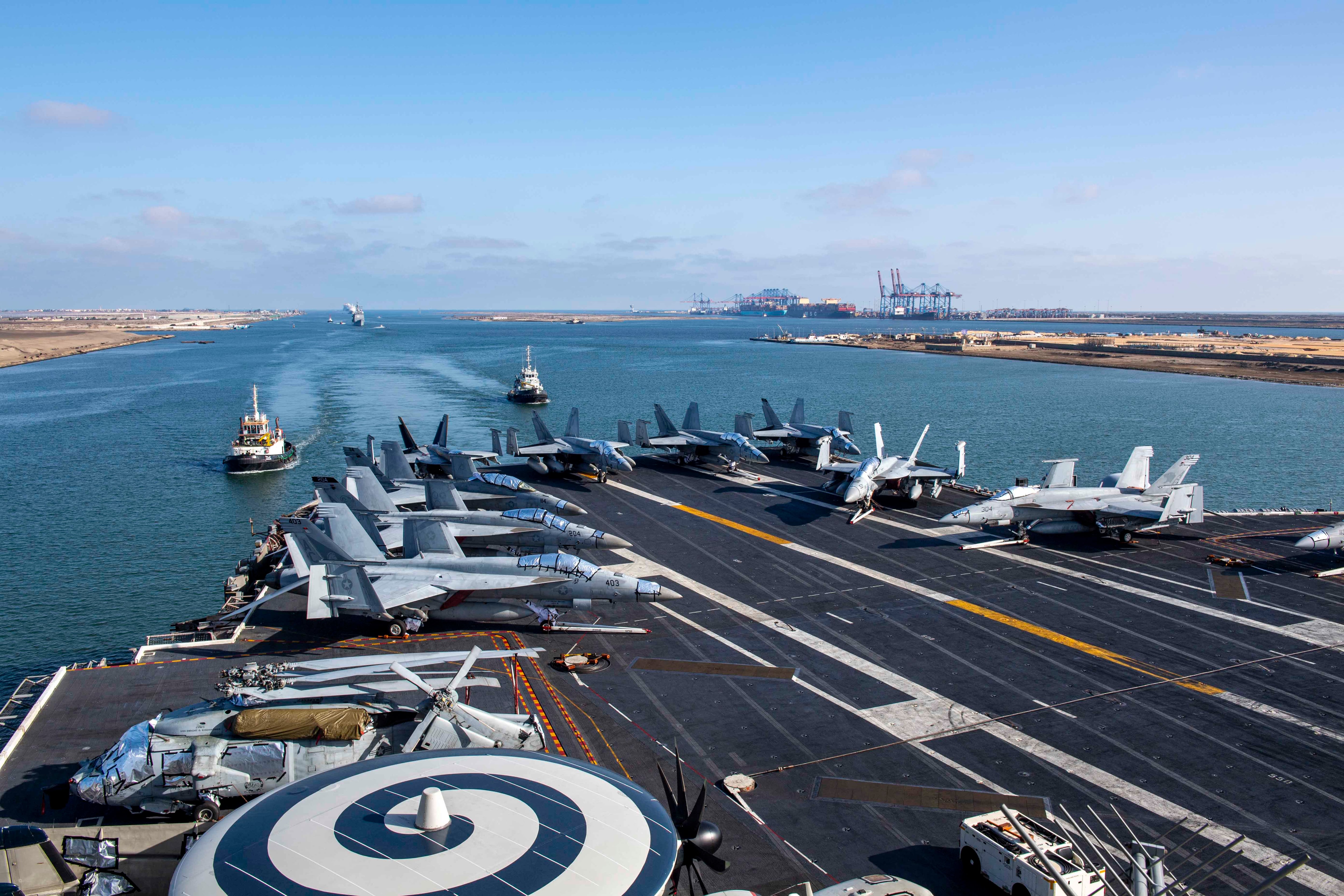
NT: What do you hope sailors take away from this deployment, as they look back on it?
Hill: When they’re 80 years old and they have their walker, maybe they’re on an oxygen tank that they say, “You know what? I was on the Ike.” And telling the stories to their grandchildren, who are probably rolling their eyes. “And I was proud to be on the Ike. It was tough, but we did a great job against the enemy.” Right? And I want them to have that veteran experience where there’s some pride in what they accomplished. You don’t always see that in American history, right? But I hope that that happens many decades from now.
NT: What’s it been like for the crew since returning from deployment, and what are the next steps for the ship?
Hill: So coming back, most sailors are doing just fine. Some said it was weird coming home – nine months away from families. For some it was lonely, because they don’t have families to go to, so they weren’t around their peers all day long because their peers went home, right? We always monitor that. We want to make sure everybody’s good. So there’s a big effort to keep track of that situation and talk about it. So I talked about it through several times. Like, what you’re experiencing is absolutely normal. If it’s too hard to handle, then you can go seek help, and we have those resources, as I talked about, but it hasn’t been anything unusual in terms of post-deployment behavior, if you will. I haven’t seen anything unusual, and I’ve done many different deployments. And even for me, it’s like, it’s weird coming home and it takes a few weeks to readjust. And we got underway recently, we did a friends and family day, one day in and out, and kind of got back into our battle rhythm.
Then we did an ammo offload for about a week to get in our battle rhythm, restore mission and purpose. And so my main thing looking forward is, how do I provide mission and purpose if we’re not at sea doing that mission, right? So our new mission is to upgrade the ship in a shipyard period, and this is based on the life cycle of ship…so that we can make the ship even better for follow-on deployments. And there’s probably a couple more deployments left in the ship’s life.
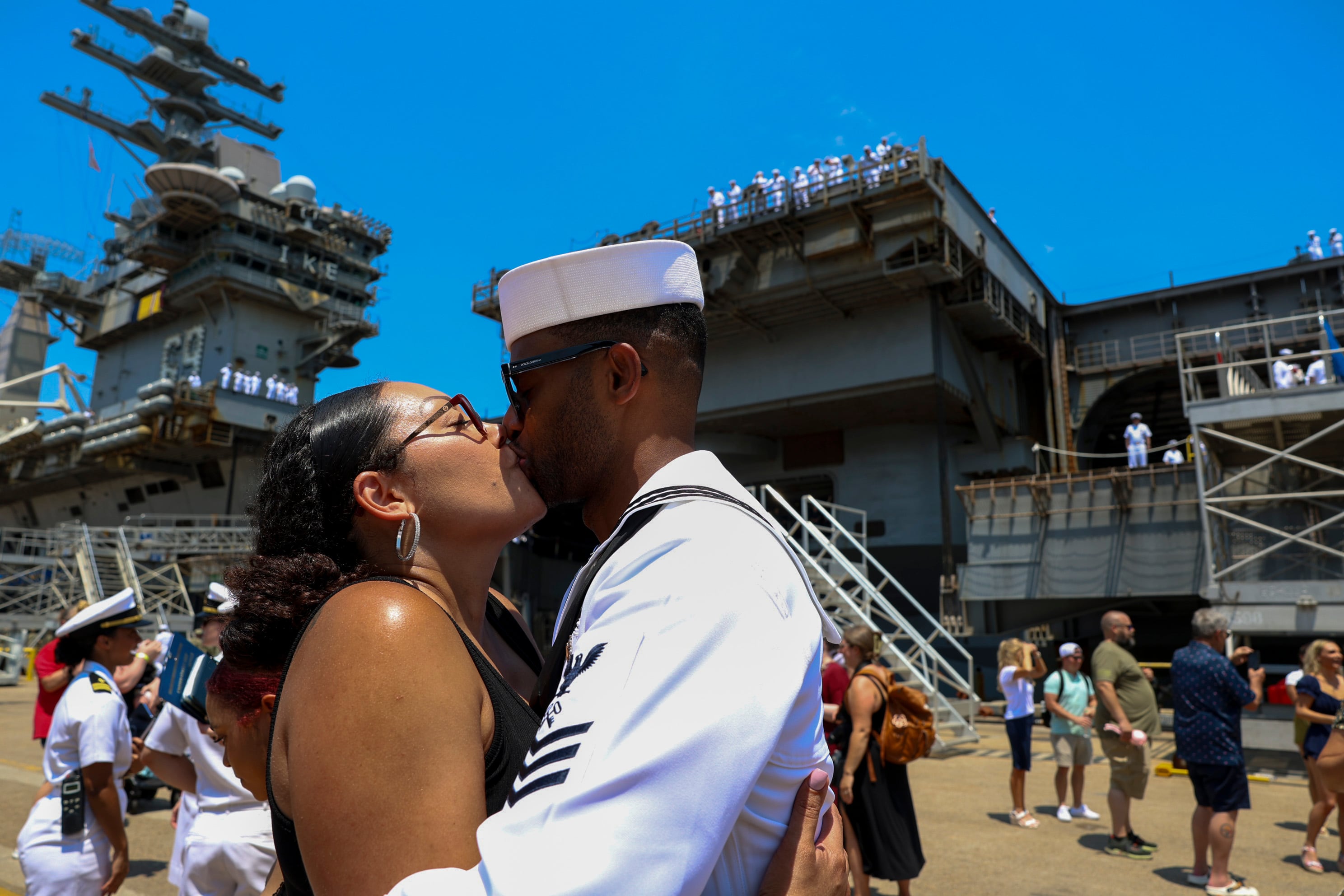
NT: How will you remember this deployment?
Hill: I might remember the fact that during some engagements, I was wearing my pajamas and my Adidas slides, and I think I’m old enough where I think I’ve earned the right to do that every now and then. People may disagree with me on that, and I’m probably indicting myself, but there were times where, you know, just not enough time to slap on a uniform or take a shower, right? We had to do work.
